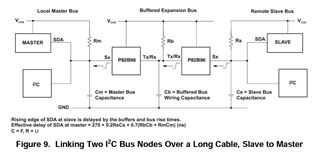Other Parts Discussed in Thread: MAX232, AM26C31, AM26C32, SN65LVDS049
Hello Community,
The P82B96 datasheet suggests some configuration for I2C communications, in this, we wish to seek clarifications for the following queries:

Query 1: Configuration
We seek clarification on whether we can use a single pair of P82B96 I2C extenders to interface multiple Slave devices (Sensors) on the remote slave bus with a single master (MCU) on the local master bus with P82B96 transmitting signals over the buffer expansion bus.
The maximum required speed is 400kHz for our use case.
Query 2: Differential Drivers
We need to transmit the data over 3m distance using CAT5e cables. Do we need differential drivers in this case?
If at all required, for increased noise immunity of the I2C bus, can we use following two differential drivers & receivers:
- MAX232 Differential driver & receiver pairs alongside P82B96 at both ends with 120Kbps
- AM26C31 & AM26C32 with 10Mbps
Are there any known obvious factors that we may have overlooked when selecting the differential drivers for P82B96?
Kindly provide your insights on these assumptions.
Thank you.


